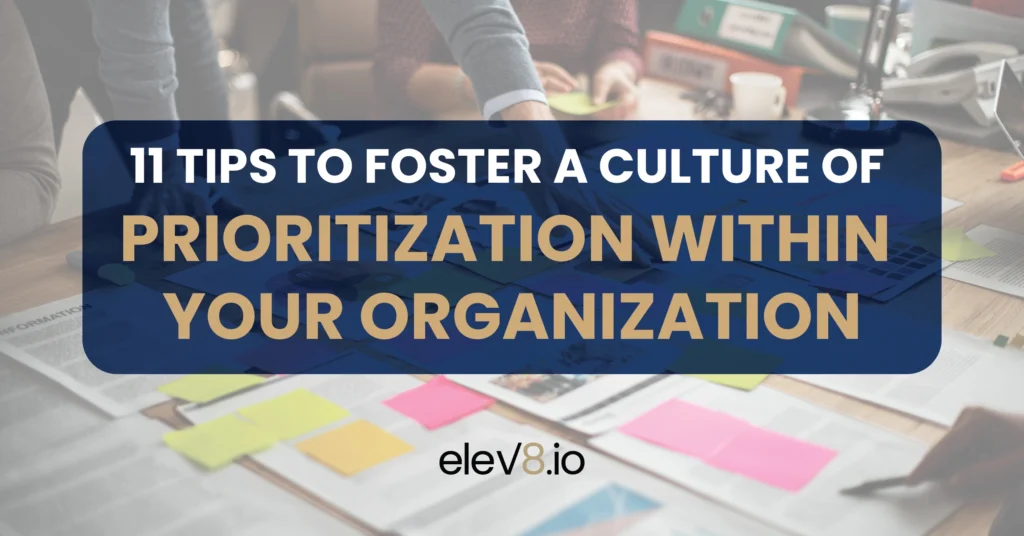I grew up as a basketballer and through the game learned many valuable lessons. From its intense coordination in pursuit of a common goal, basketball mirrors the dynamics of a thriving business.
One of the key elements that separates championship teams from the rest is their ability to prioritize effectively. Similarly, fostering a culture of prioritization within your organization is vital for achieving optimal results.
Just as a basketball team must allocate its limited time and resources strategically, organizations must identify and focus on their most important objectives.
In this blog, I’ll explore how to cultivate a culture of prioritization, drawing inspiration from the world of basketball to create a winning formula for success. So, grab your kicks and let’s hit the court!
Prioritization: A Key to Success
Prioritization is essential for any organization to succeed. When teams are able to prioritize tasks, projects, and objectives in an effective way, they are able to achieve more with less effort and time. At the same time, prioritization helps organizations stay focused on what matters most—accomplishing their goals and delivering results.
For B2B and SaaS companies that provide services or products to other businesses, prioritization is even more important. Companies must be agile enough to quickly react to changes in the market, customer needs, or employee preferences.
Running a successful B2B and SaaS company can be challenging, especially when it comes to managing priorities. Poorly managed priorities can lead to missed opportunities, lack of collaboration, and even burnout among employees. Knowing this, fostering a culture of prioritization within your organization is essential for both success and sustainability.
Prioritization is not just about getting tasks done; it’s about using limited resources in the most effective way possible. With a clear strategy and the right system of management, companies can ensure that they are always making the best decisions to reach their goals.
Tips to Creating a Culture of Prioritization
By following these tips, you can help your team work smarter and more efficiently while still achieving exceptional results. So start prioritizing today!
1. Set a Vision
Establishing a direction or vision is the first step. And create it with your team, making sure they understand why. Put a timeframe on it so everyone knows when it is reached.
2. Define Your Organization’s Priorities
Organizations need to have an understanding of what their goals and objectives are before they can start prioritizing tasks and projects. This means developing a clear strategy that outlines the company’s priorities, as well as how they will be achieved.
3. Why Prioritization Is Important
Just as in a fast-paced ball game, in today’s business environment, it’s more important than ever for companies to prioritize tasks and projects. Prioritization allows leaders and managers to focus on what’s most important, ensuring that resources are allocated efficiently and effectively.
Without prioritization, businesses risk getting bogged down in unimportant or low-priority tasks, which can lead to missed opportunities and decreased productivity. By taking the time to prioritize, companies are better able to make strategic decisions, stay competitive, and achieve their goals.
4. How Objectives & Key Results Help
Identifying objectives and key results (OKRs) is crucial for success. OKRs provide a framework that helps organizations focus on their priorities and achieve their desired business objectives.
By breaking down large goals into smaller, more manageable objectives, OKRs enable teams to prioritize their work and allocate resources effectively. With clear guidelines and measurable metrics, companies can see where they stand in terms of progress and take corrective measures if necessary.
OKRs not only facilitate prioritization but also increase transparency and accountability, fostering a culture of excellence and continuous improvement.
5. Remove Other Work
By definition, a priority is more important than other tasks. So if other things are less important you have several choices: delay them, cancel them, or reallocate resources to the more important priorities. Failing to cater for existing work can increase job stress for all. This may result in poor performance or demoralization.
6. Empower Employees to Set Their Own Priorities
When you allocate more resources to important work, you signal to your team and the organisation that this work matters.
Allow employees to take ownership over individual tasks or projects by giving them the freedom to choose which tasks they prioritize and how much time they allocate to each one. This not only gives employees more control over their work, but it also encourages them to think critically about how best to use their time and resources.
7. Provide Clarity and Transparency
Clear communication is key when it comes to achieving goals and setting priorities. Providing clarity and transparency of priorities and goals ensures that everyone is on the same page and working towards a common objective.
It eliminates confusion and misunderstandings, resulting in a more efficient and effective team. With everyone understanding the importance and urgency of each goal and priority, teams can work together to reach those goals faster and with greater success.
Transparency fosters a collaborative and accountable work culture, where everyone feels comfortable raising questions or concerns if needed, ultimately leading to better results and outcomes.
8. Establish Accountability
A basketball team runs on accountability where every player knows their role and plays it with commitment. Every team member needs to take responsibility for their role and be held accountable for the outcome of their work.
When everyone is held responsible, it creates a sense of ownership and encourages teamwork. By establishing clear expectations and guidelines, each team member can be confident in their responsibilities and ensure project success.
Accountability also promotes communication and encourages collaboration, leading to better project outcomes. In short, accountability ensures that everyone is working towards the same goal and gives each team member a sense of accomplishment in achieving it.
9. Create a Process for Managing Priorities
Set up a system that allows teams and individuals to track their progress and re-prioritize as needed. This will help ensure that tasks are completed on time and that the team is focused on the most important objectives.
10. Gain Buy-In From Leadership and Stakeholders
Regularly communicate with stakeholders about what needs to be done, how it’s being prioritized, and why certain decisions were made. This helps keep everyone informed and ensures that tasks are addressed in an appropriate order of importance. But you need to be prepared to have tough conversations with your stakeholders about the impacts of changing priorities.
11. Encourage Collaboration and Communication
By fostering an open dialogue among employees, businesses can create an environment where ideas are freely shared and decisions are made collaboratively. This not only improves productivity and efficiency, but also enhances team cohesion and morale.
Encouraging collaboration and communication also helps break down silos and encourages employees to work towards a common goal. By encouraging open dialogue, businesses can ensure that everyone’s voice is heard and that all team members are working together towards shared objectives.
Ultimately, fostering collaboration and communication is crucial to building a positive and productive work culture, driving innovation and success. Just like on the best ball teams.
Play Ball!
The key to successfully fostering a culture of prioritization is creating an environment where everyone involved is reliably informed, held accountable, and has developed the same priorities.
Defining the vision and need for prioritization, setting clear OKRs, providing clarity and transparency about goals and priorities, establishing accountability for each project in place— all these things will enable a healthy work environment that works together as one.
I developed the Goals Grit & Greatness Planner to help you create your vision and priorities while also encouraging creativity and focus on goals. With it as a tool, and by following these steps, you can take your company straight to the basket!






